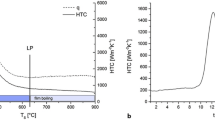Conclusions
-
1.
Water-air mixtures in which 3 m3/m2·h of water is used do not produce the cooling rate necessary for increasing the hardness of low alloyed steel sheets 12 mm thick or thicker.
-
2.
Quenching with a spray makes it possible to regulate the cooling rate and the degree of hardening of low alloyed steel.
-
3.
Quenching by sprays is the most effective for sheets 15–25 mm thick.
Similar content being viewed by others
Literature cited
L. I. Gladshtein, Zavodskaya laboratoriya, 8, (1961).
M. E. Blanter, N. A. Kulkov, et al., MiTOM, 12 (1958).
Ya. I. Spektor and A. P. Gracheva, MiTOM, 3 (1962).
V. I. Raspacienko and V. P. Kulikov, Stal', 5 (1962).
G. French, Study of Quenching of Steel [Russian translation], ONTI (1933).
L. V. Petrash, Quenching Media [in Russian], Mashgiz (1959).
Additional information
Institute of Design of Steel Construction
Translated from Metallovedenie i Termicheskaya Obrabotka Metallov, No. 12, pp. 2–6, December, 1964
Rights and permissions
About this article
Cite this article
Gladshtein, L.I. Use of sprays for quenching low alloyed steel. Met Sci Heat Treat 6, 716–719 (1965). https://doi.org/10.1007/BF00660226
Issue Date:
DOI: https://doi.org/10.1007/BF00660226




